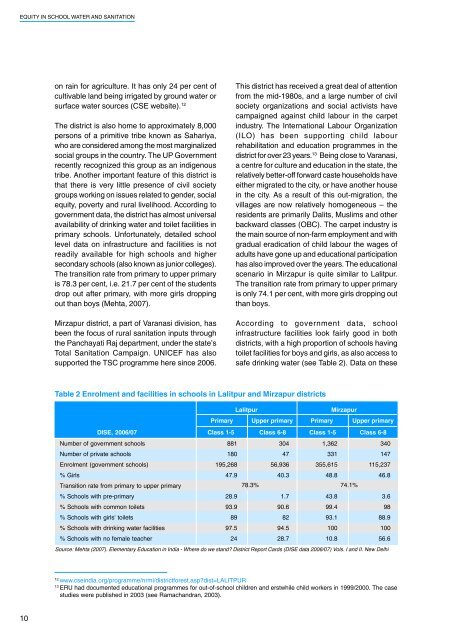Equity in School Water and Sanitation
Equity in School Water and Sanitation
Equity in School Water and Sanitation
Create successful ePaper yourself
Turn your PDF publications into a flip-book with our unique Google optimized e-Paper software.
EQUITY IN SCHOOL WATER AND SANITATIONon ra<strong>in</strong> for agriculture. It has only 24 per cent ofcultivable l<strong>and</strong> be<strong>in</strong>g irrigated by ground water orsurface water sources (CSE website). 12The district is also home to approximately 8,000persons of a primitive tribe known as Sahariya,who are considered among the most marg<strong>in</strong>alizedsocial groups <strong>in</strong> the country. The UP Governmentrecently recognized this group as an <strong>in</strong>digenoustribe. Another important feature of this district isthat there is very little presence of civil societygroups work<strong>in</strong>g on issues related to gender, socialequity, poverty <strong>and</strong> rural livelihood. Accord<strong>in</strong>g togovernment data, the district has almost universalavailability of dr<strong>in</strong>k<strong>in</strong>g water <strong>and</strong> toilet facilities <strong>in</strong>primary schools. Unfortunately, detailed schoollevel data on <strong>in</strong>frastructure <strong>and</strong> facilities is notreadily available for high schools <strong>and</strong> highersecondary schools (also known as junior colleges).The transition rate from primary to upper primaryis 78.3 per cent, i.e. 21.7 per cent of the studentsdrop out after primary, with more girls dropp<strong>in</strong>gout than boys (Mehta, 2007).Mirzapur district, a part of Varanasi division, hasbeen the focus of rural sanitation <strong>in</strong>puts throughthe Panchayati Raj department, under the state’sTotal <strong>Sanitation</strong> Campaign. UNICEF has alsosupported the TSC programme here s<strong>in</strong>ce 2006.This district has received a great deal of attentionfrom the mid-1980s, <strong>and</strong> a large number of civilsociety organizations <strong>and</strong> social activists havecampaigned aga<strong>in</strong>st child labour <strong>in</strong> the carpet<strong>in</strong>dustry. The International Labour Organization(ILO) has been support<strong>in</strong>g child labourrehabilitation <strong>and</strong> education programmes <strong>in</strong> thedistrict for over 23 years. 13 Be<strong>in</strong>g close to Varanasi,a centre for culture <strong>and</strong> education <strong>in</strong> the state, therelatively better-off forward caste households haveeither migrated to the city, or have another house<strong>in</strong> the city. As a result of this out-migration, thevillages are now relatively homogeneous – theresidents are primarily Dalits, Muslims <strong>and</strong> otherbackward classes (OBC). The carpet <strong>in</strong>dustry isthe ma<strong>in</strong> source of non-farm employment <strong>and</strong> withgradual eradication of child labour the wages ofadults have gone up <strong>and</strong> educational participationhas also improved over the years. The educationalscenario <strong>in</strong> Mirzapur is quite similar to Lalitpur.The transition rate from primary to upper primaryis only 74.1 per cent, with more girls dropp<strong>in</strong>g outthan boys.Accord<strong>in</strong>g to government data, school<strong>in</strong>frastructure facilities look fairly good <strong>in</strong> bothdistricts, with a high proportion of schools hav<strong>in</strong>gtoilet facilities for boys <strong>and</strong> girls, as also access tosafe dr<strong>in</strong>k<strong>in</strong>g water (see Table 2). Data on theseTable 2 Enrolment <strong>and</strong> facilities <strong>in</strong> schools <strong>in</strong> Lalitpur <strong>and</strong> Mirzapur districtsLalitpurMirzapurPrimary Upper primary Primary Upper primaryDISE, 2006/07Number of government schoolsNumber of private schoolsEnrolment (government schools)% GirlsTransition rate from primary to upper primary% <strong>School</strong>s with pre-primary% <strong>School</strong>s with common toilets% <strong>School</strong>s with girls' toilets% <strong>School</strong>s with dr<strong>in</strong>k<strong>in</strong>g water facilities% <strong>School</strong>s with no female teacherClass 1-5 Class 6-8 Class 1-5 Class 6-8881180195,26847.928.993.98997.5243041,3624733156,936 355,61540.348.878.3% 74.1%1.743.890.699.48293.194.510028.710.8340147115,23746.83.69888.910056.6Source: Mehta (2007). Elementary Education <strong>in</strong> India - Where do we st<strong>and</strong>? District Report Cards (DISE data 2006/07) Vols. I <strong>and</strong> II. New Delhi12www.cse<strong>in</strong>dia.org/programme/nrml/districtforest.asp?dist=LALITPUR13ERU had documented educational programmes for out-of-school children <strong>and</strong> erstwhile child workers <strong>in</strong> 1999/2000. The casestudies were published <strong>in</strong> 2003 (see Ramach<strong>and</strong>ran, 2003).10












